
Stewart Home is a counter-cultural icon who, as a writer, artist and thinker has been involved with cultural and counter-cultural activities for more than 30 years.
First of all could you tell us a bit about your background, and what propelled you into working in a public arena?
I didn't have any background to propel me into doing stuff in public, most of the kids I went to school with either went on to work in factories or joined the army. My school did produce a few really famous male rock musicians and one famous female nude model! I didn't like the music made by the rock stars who’d been to my school and there weren't the same opportunities to make a career from nude modelling for boys at that time. I even turned down the odd offer to appear in gay porn movies, where I'd get a hundred quid and they didn't even need to show my face, just my arse.
I was very into music, and started writing reviews in the late seventies to get free records and get into gigs for free. I also started playing in bands, but mainly they weren't very good. The first band I was in that played proper gigs, as opposed to parties, was a ska band called The Molotovs and we murdered tunes like "Johnny Too Bad" and "54-46 Was My Number". The next band I was in used to murder tunes like "Louie Louie" and "Real Cool Time", but did a rather good version of "Gloria" - and we were more inclined to play original material and keep covers for encores, so that people would have already decided they liked us before we gave them the opportunity to judge what we were doing against an earlier version of a song.
So, we're talking about the late 70s / early 80s . A time before the Internet, satellite TV, mobile phones, cheap air flights, cheap heroin etc. I think what was distinctive about that era, which perhaps isn't so true now, is the way complex social networks grew around such artefacts as vinyl records, and xeroxed 'zines, which seemed a possible way out of the mundaneity of everyday life. And there was perhaps an occasional sense of community in opposition to Thatcher and the destruction of the welfare state.
I get the impression that from a very early age you had a high degree of motivation, and that motivation was towards activities that many would find difficult and materially unrewarding, even futile. For example, back in 1980, it wasn't considered hip to be an artist and few people would visit galleries. Likewise the novel wasn't exactly a "weapon of choice" back then. Forming a band would also have been an effort of self-organization, since musical instruments were relatively more difficult and expensive to get hold of.
Yes, back at the end of the 70's I was very aware of the communities formed around bands and fanzines. However, after a while I found that scene a bit unsatisfying. I liked music a lot but things got very narrowed down into genres, and this was a particular problem on the punk scene which seemed to view itself as much more progressive than other youth cultures but in practice tended to be more bigoted.
I liked some punk bands, although in retrospect a lot of what I liked wasn’t really punk but power pop or pub rock dressed up to look like punk. I also liked soul and funk. Most of those on the punk scene really looked down on you if you also liked Afro-American music, and there was a sometimes unconscious and sometimes not so unconscious racism in this. Kids into disco, northern soul and funk, tended to be more open minded about the different types of music someone like me might have been into. And this punk bigotry became even more of a drag when the punk scene split into Anarcho, Gothic, Oi! etc. Also when I was writing in or producing my own zines I didn’t just want to cover music and this often got a bad reaction. I just wanted do be involved in something more interesting than these increasingly narrow punk scenes.
I used to also spent a lot of time at cinemas around London and in particular The Scala, first on Tottenham Street and then after it moved to Kings X (above left) in the early eighties. And I was reading a lot of the modernist classics, from Robbe-Grillet to Burroughs – as well as seeing them on film, Burroughs in Towers Open Fire and The Cut-Ups and as narrator of Witchcraft Through The Ages (below right); Robbe-Grillet as a screenwriter on Last Year At Marienbad and as writer/director on Trans-Europe Express etc.
Mike Heart who was on the fiction desk at Compendium from about 1979 on told me years later he could tell I was one of the more interesting kids coming in to buy books. He said he divided the teenagers like me who were buying books from then into two groups, the ones worth encouraging with their reading and the ones who weren’t. So if you went in and bought Kerouac then Mike would just take your money, but if like me you bought Burroughs he’d suggest other stuff you might be into and try and get it cheaply for you too. But I met a lot of people who’d turn me onto stuff I didn’t know, not just Mike Heart.
So it wasn’t like today when you could just get this amazing range of information from the internet, you’d have to seek it out.
But there were older people around who’d turn me onto a lot. It required a certain amount of motivations, but it wasn’t all unaided effort. These sort of interests weren’t encouraged at school, since we didn’t even do schlock like Shakespeare, the English teacher told my class we were too thick for the Bard which was why we did the only examining board in English literature where you could do all modern texts. And we were like the elite of a very crap school, seven streamed classes in the year and only in the top two were you allowed to do O-levels as it was then. The three beneath you could do CSE, which in the old system was seen as not nearly as good as an O-level, then beneath that were the non-exam classes for those considered not good enough to do CSE, the bottom classes were mainly made up of kids from the children’s home and kids from Muslim families. The school was completely institutionally racist, it must have been about 25 percent Muslim kids and yet there was only one Muslim girl in the O-level classes, the rest were in the CSE and non-exam classes! But that was the norm back then in the seventies, when I left school I went and worked in a factory for a while and I quickly got a cushy job in the finishing department coz I was literate and numerate so I could count and sign everything out. A lot of the white guys in there were illiterate, and those that weren’t got the easy jobs, and if they were older than me got to be the foremen. There were Muslims who had the literacy and numeracy to take these posts but they just weren’t given them. So I didn’t grow up with anyone who knew anything about the art world or knew writers or anything. Music seemed a bit closer coz my school had produced some well known rock musicians. But I just found the world interesting, so I wasn’t gonna let the teachers telling me and all the other kids in the school we were thick hold me back.
Can you tell me something about 'Smile' magazine, and the context it arose in? At the time, it looked like it might have been difficult and expensive to produce. You wouldn't have been using computers back then, and there wouldn't have been digital printing. How did you distribute it?
'Smile' started because I was doing these funny little poems, mainly as a reaction to the stuff I was hearing read at clubs back then. In the very early eighties I used to go to places like Evening Falls/Suns of Dada in the basement of Slightly Oliver’s Wine Bar in Holborn, London. They’d have people like Anne Clark doing this supposed street poetry, but I really hated the mix of socialist realism and gothic elements in a lot of what was being done then. It was really really bad aesthetically and I saw it as the sub-literary equivalent of the very worst music that came out of the punk/new wave scene: bands that really suck like Siouxsie and the Banshees or The Cure. So I’d write these really banal and short still life type poems about fruit and vegetables and get up and do those as a way of taking the piss out of what was poetically dominant on that scene...So the first couple of issues of Smile were just a way of collecting some of this spoken word material together. I put the first one together at the end of 1983 and it was published in January 1984, then I did the second issue within two months of that…
I suggested in the first issues of Smile that other people should do magazines with the same name, a kind of neo-dadaist joke although I was quite serious about getting other people to use the name. Then I ran into the Neoists, and discovered Dave Zack’s Monty Cantsin project, where lots of people would use the same performing name, which was very much along the same lines.
I got a cheap print deal via someone I knew from political groups for the first couple of issues. Then the print shop where that was done closed down. The next few issues weren’t so well produced. But they were all off-set apart from issue 6 which was silk-screened. They were done in runs of somewhere between a thousand and two thousand. Then I got some better printing sorted out, done at a discount but I still had to go easy on my dole money to have the readies to pay for it. I’d eat really cheap food, scavenged vegetable, beans, bread, pasta, and save money out of my dole cheques to pay for printing and also doing stuff in galleries or mail art. Art openings were better then than today 'coz you could get free drinks and they’d often have food too! So as far as possible I’d live on other people’s dip. Verso book launches were particularly good for free food, so I’d go early to those. They bought all these Marks & Spencer's nibbles, very flash!
Then I borrowed an IBM compositor, which went around political groups I was involved with, and I’d use like spot colours on the cover, and glossy paper. I’d learnt to touch type when I was sixteen so I was quite fast with the compositor, and it wasn’t really that much more complicated than an electric typewriter, it didn’t take long to learn how to use it. Back then looking professional really helped shift stuff. In the mid-eighties most underground publications were done on typewriters, so the fact that I typeset mine myself really made it look better and got it to stand out. I also typeset stuff for a load of other people when I had the compositor.
Volatile memory and you could put in about a column and a half of text at a time in the small type sizes I favoured. You’d programme it to stop and you’d have to change the golf-ball head if you wanted to change the type or put in italic or something. But compared to a lot of what was around it looked really flash. And I was parodying British newspapers and advertising, so on one issue as a joke I put ‘Forward With Libya’ rather than the more famous ‘red top’ slogan ‘Forward With Britain’, and 'coz it looked good a rumour went round I was funded with Libyian money, although it was just my dole cheques.
I made the magazines really cheap too, like 30p, but I’d make at least costs back. It was very easy to shift 2000 copies then just through the radical bookshops around London and out to a few other outlets beyond London that requested it. Younger kids forget how different it was in that pre-Internet era. It is much harder to shift publications in those kind of numbers now than it was back then. I’d just get on my bicycle with the magazines in a rucksack on my back and take them around myself. I was in inner London but I liked cycling so I thought nothing of going all over greater London distributing stuff on my bicycle. Things that went further were mailed or I took them if I was passing through.
Punk had radicalised a lot of people at the time: partly in opposition to an increasingly right-wing government. What were the other influences and cross-currents around at the time as you recall them affecting you?
The big thing for me as a kid in terms of political influence was a bit earlier than that. The three day week then the two elections in 1974. Heath had that line about who rules the country me or the miners; and I’d be going to school through that and it was nothing but a sea of Labour posters all the way there.
Obviously Labour wasn’t radical but because of the rhetoric of the Tories as a 12 year old I felt we were really close to a working class revolution, which of course was a very exciting prospect! I was already very anti-monarchist and anti-capitalist before punk. Partly it was a great way to wind up the teachers. I’d get Capital by Marx out of the local library and carry it around school, although I didn’t read a word of Marx until after I’d left. But it was a great wind-up to the teachers. I got a copy of Willie Hamilton’s anti-monarchist book “My Queen & I” when that came out in paperback and I’d put that on my desk; it really annoyed the teachers.
So to me punk wasn’t really that important for those political attitudes they were already there. In retrospect I think punk wasn’t that useful, it kinda killed rock and roll, and also there was an incredibly bigotry among sections of the punk scene against disco and soul, which just wasn’t helpful. Looking back on it, I think punk was massively over-rated. There were interesting things around it, but often that was power pop or pub rock dress in punk rags as a way of attracting an audience. Listening to bands like the Sex Pistols and The Clash now, they sound pretty awful.
What was it that drew you to Neoism subsequently? Is it possible to describe what Neoism was?
Neoism was just a bunch of people internationally who appeared to be doing the same things I was doing. So it appealed for that reason, and because I’ve always considered collective activity on cultural and other fronts to be important. As far as the name goes, Neoism can be summed up with the explanation that it was a prefix and a suffix without any content… But actually you can see it very much in a tradition of avant-garde anti-art, more running through dada and fluxus and mail art until I came along and injected some situationist influences. But some of those involved claim it wasn’t anything to do with art and was instead occult speculation or a new way of living, while others claimed to be artists. But if those involved in Neoism were artists, they certainly weren’t money artists but ‘real’ ‘undergrounders’.
Later in the 80's you had shows at prestigious venues like Transmission Gallery in Glasgow and Chisenhale in London amongst others (pictures left and above x2). How did these come about? How did the shows relate to your other interests and concerns? Did they embody particular political or philosophical ideas for example?
I was interested in demonstrating that art was a process of bureaucratic manipulation, that art was whatever those in a position of cultural power said was art. So I set out to establish myself as an artist to prove that anyone who understood the art system could manipulate it in this way. For this reason it was important for me to do gallery shows. Getting in those legitimate spaces and getting reviews in the national press and art magazines - which was achieved with those shows you mentioned - proved that someone like myself could just set out to put themselves in the position of an artist, you didn’t need the right background or training, you just needed to understand how to manipulate the institution of art.
But those shows were also really interesting group collaborations involving not only me but also people like
Stefan Szczelkun and Ed Baxter who now runs
Resonance FM. The 'Art In Ruins' duo Hannah Vowles and Glyn Banks were also involved. We had huge fights and arguments about what we were doing and how this related to our opposition to the mainstream art world and culture at that time. I don’t think everyone was coming from the same position but we all wanted to smash culture as it existed at that time and remake it in a less elitist form. But then, of course, the yBa came along and things got worse.
I was messing around with stuff, edging my way into galleries. At that time people in the London art world didn’t know much about Fluxus and the Stiuationists, but I’d been doing research into them and published stuff in Smile relating to that, so people realised I knew about that and thought I’d been interesting to know and work with. Stefan Szczelkun I came across through mail art but he was in South London and invited me to the first Our Wonderful Culture show opening. I think Stefan must have pointed me out to Ed Baxter, because he came over to me and started up a conversation about some of the stuff I was writing up in Smile, then he took me across to meet Hannah Vowles and Glyn Banks. Stefan had been asked to do a show at Chisenhale and I think pretty much that night it was all agreed we’d try to do something collectively. So that was how that and the Transmission show and later ones in Malmo and Luton came about. But at the same time I was meeting other people in other ways. I was putting pieces in to the group shows at DIY Gallery that used to be in the Elephant and Castle shopping centre. So I was dealing with people there who were interesting like Chris Saunders, but it wasn’t just him there were a load of other people around him.
The Festival of Plagiarism, which you instigated and organised, in January and February 1988 was a large number of events, including art exhibitions, music perfomances, video, actions (such as National Home Taping Day) and performances to which anyone was invited to contribute. Aimed squarely at "the false individualism of consumer society", as I remember, it took its ethos from "underground" DIY modes of collective organisation. The events ran in community spaces such as Community Copy Art and small galleries rather than in "establishment" art spaces. A major achievement of the FOP was to show that it is possible to organise an ambitious cultural event without enough money to cover any more than the most minimal of expenses - the festival had no sponsor, two of the three main organisers were registered as unemployed and the third was on a minimal wage from a book distribution service at the time.
My own contribution to the festival was to organise & perform in a loud samplist/exploitation night at the London Musicians Collective as Spanner Thru Ma Beatbox, along with Mixmaster Morris' Irresistible Force and Pornosect. Who else do you remember as being important contributors to this event and what else can you say about plagiarism?
The answers to that are all really in The Festival Of Plagiarism booklet, the text of which has been on my website for a few years. There are a few pages of that starting at: http://www.stewarthomesociety.org/festplag.htm and you’ll find most of the names of those involved there too. So no point in me repeating them here.
Graham Harwood is someone I haven’t mentioned who really involved himself in that.
I think the point of using the term plagiarism was that it was provocative in a way that appropriation and detournement weren’t, although what we did related to both those practices. Again we had a lot of arguments about what we were doing and why, particularly Ed Baxter and me. Hannah Vowles and Glynn Banks weren’t involved with 'The Festival of Plagiarism', but they used to like arguing too when we did the group installations.
The piece I’ve given the link to takes a very different line from the report Ed Baxter produced for an early issue of Variant. But we were all incredibly serious young men and women back then, but also very fond of jokes. The humour I favoured was a little more low-brow than what Ed was into at the time. However, through it all we’ve remained fast friends and have remained antagonistic towards commodified culture. So I think the message here and in the other things we did was that if there is to be a better world, we have to make it ourselves. And that was kinda the message of the Art Strike too: it’s up to us to make it new and seize control of the world, and the elitist art system only exists to hold us back, which is of course why we need to smash it.
Your book 'The Assault on Culture: Utopian Currents from Lettrisme to Class War' was published around the same time: in 1988 (front cover left). Am I right that it included essays and ideas written during the previous 10 years and published in magazines like VAGUE?
VAGUE really caught people’s imagination in the eighties and shifted a lot of copies, and I did contribute to it. But that historical textual practice about the avant-garde was much more developed through my own publications, particularly Smile magazine. However, while the research went back over quite a few years, 'Assault On Culture' was written from scratch in about six months in 1987, the year before it was published. It didn’t incorporate earlier texts although it did incorporate information from some earlier texts, with the main source of these being issues 8 and 9 of Smile.
During the nineties you turned more towards writing novels, ostensibly as a way to earn a living, but remained involved with the art world through contacts like Matthew Higgs. You were, for example, included in Life/Live in Paris in 1996, and made work for Imprint 93 (eg pin badge left below). But I sense that your interest in art had changed. Had you lost some of that residual belief in art as a force for change perhaps?
I wrote my first two novels in the eighties, and was writing the shorter fictions that led into them from the mid-eighties onwards. After eighties I was just a little bored with the art world and didn’t particularly have plans to go back into it once I’d done the Art Strike from January 1990 to January 1993. However, Mathew Higgs was very keen for me to do stuff with him, so eventually I did and then with various other people.
Matthew was very keen to organise an alternative to the tedium of the yBa, something I definitely sympathised with. But in the nineties there was a lot of very interesting non-literary activity that was also well outside the art world in the form of things like London Psychogeographical Association, Luther Blissett Project, Association of Autonomous Astronauts. So there were many prank activities going on, I was running the Neoist Alliance - which had nothing to do with the old Neoist Network.
These non-commodified practices which attempt to overflow the canalisation of culture and politics just seemed very exciting in comparison to the art and literary worlds. So that was really where my main focus was. But also I’d be asked to go to a lot of very pleasant art world parties, and I’m not one to forgo a good time…
During the Art Strike I’d signed back on the dole but from the mid-nineties on I was supporting myself mainly from the royalties from my novels. They were being translated in Europe and because the pound wasn’t too high that was a nice little income, not as much as I’d have got from a crap factory job but enough to live on. So it is true to say my novels were at that time my main source of income.
I understand you interviewed Ralph Rumney - the only English member of the original Situationist group - for Art Monthly a few years ago. What many don't know is that not only was he an accomplished abstract painter (see picture below left), but that he actually lived in St Ives and worked with Barbara Hepworth for a while.
At various points in the last 20 years, and before, the Situationists have been invoked by artists interested in art or other cultural activities purporting to have a radical edge. What do you make of the ways in which these ideas have been used?
Nothing would surprise me about Ralph Runmey, he did so many different things and had so many different lives. I found the way he’d completely change the style of the art he made every few years fascinating. But yes I interviewed him a couple of times, once for The Assault On Culture and then a couple of years later for Art Monthly in 1989, the latter interview is online at http://www.stewarthomesociety.org/interviews/rumney.htm
As far as the art world goes, I don’t think many people within it know what the situationists were really about – i.e. proletarian/communist revolution - they just invoke the name as a kind of buzzword intended to signify some kind of vague radicalism. Will Self does much the same in the literary world, but I get the impression he’s more interested in his status as a middle class literary gentleman than creating a world without money or classes and abolishing alienation. There is no point getting heated about this, I’m not precious about the situationists and given their obsession with recuperation they presumably expected as much. As anything more than a vague buzzword the situationists are only of any use if you understand them in the context of the ultra-left and can see that their weaknesses stem from them being too reliant on councilist traditions, which they’d never really attempted to synthesise with Bordigism. That said, they understood well enough the necessity of constantly reforging the passage between theory and practice, whereas their invocation in the art world is more generally idealist. I think the interesting use of elements of what they did occurs elsewhere, and in the 1990s this might be found in the London Psychogeographical Association, The Association of Autonomous Astronauts or the Luther Blissett Project. For me the Situationist International is most interesting up to 1962, before the split between the more ‘cultural’ and more ‘political’ factions, because I’m committed to overflowing all divisions between culture and politics.
You are still busy with a number of projects. For example you curated a show called Hallucination Generation at the Arnolfini (presumably with current Tate St Ives director Martin Clark) in 2006 and you've been involved with making documentaries with Jeremy Deller and the K-Foundation. Could you summarise some of your other current projects so that we can link to them?
One of the main things I’m doing at the moment is editing the Semina series of experimental novels for Book Works. In the past ten days or so I’ve done three public readings and a talk on Ray Johnson and mail art, but what I do varies all the time. Public events are listed on the home page of my website.
But a lot of stuff is more spontaneous, so it just kinda happens with the people who are around. Another thing that is coming up is a big Art Strike Biennial meeting in Alytus in Lithuania this August. And of course my blog on the back end of my website sometimes reveals where I’ve just been or what I’ve just been doing. That said, there generally isn’t any reason to blog about my readings and talks, although if something a bit different happens there might be. But the blog is a good way to keep things moving along, critique, discussion and practice too of course! The comments are to me just as important as the main part of the blog. I think you can see new ways of writing emerging with this… it is a lot looser and freer than printed texts, and a lot less fixed, I love its incompleteness…
On your blog you were critical of Altermodernism: the concept, perhaps, more than the show. But what do you make of Bourriaud’s take on global culture? A feature on artcornwall.org suggested that its in the interest of big institutions like the Tate, like other types of corporations, to attempt to increase their influence world-wide by embracing and promoting a notion of global culture that is actually rather spurious. What do you make of this? What are the other issues highlighted by this show in your view?
I haven’t come across anyone in the London art world who takes the idea of Altermodern seriously. I don’t think Bourriaud knows what modernism and post-modernism are, and for me they are linked – as I first said in the mid-eighties, two stages in a single trajectory – they aren’t opposed to each other. Bourriaud is probably better suited to working for Primark than in galleries, he’s certainly the curational equivalent of a cheap fashion brand. You can almost imagine the meetings they had for the Tate Triennial: “So we’ve done the winter Zeitgeist, which was post-modernism, so I’ve got this great idea to make it over as the Altermodern for our Spring Collection.” Completely ridiculous!
The only people who took the Altermodern seriously were super-sad indie-kids like Nick Currie. And Currie’s blog defences of Altermodern were pretty marginal; he even admitted in one of the comments he hadn’t even seen he show, because he was in Berlin not London! No one but an indie-wanker could take Bourriaud seriously as an intellectual, and obviously the odd twerp like Currie who misidentifies Bourriaud as being an intellectual isn’t worth engaging with since he is so intellectually inert he doesn’t appear to have even the slightest inkling of how intellectuals function as a class fraction. Whether you agree with them or not, people like Peter Osbourne and those around Radical Philosophy in London are intellectuals - you know “thinkers” - but Bourriaud isn’t an intellectual he’s just pathetic fashion victim dressed in truly shitty designer knitwear. Likewise, Altermodern is just a haphazard collection of trendy art that Bourriaud claims to likes. It has no substance.
My view is that the Tate decided to run with Altermodern as a marketing strategy because it is desperate to cover up the patchy nature of its collection. In the US you have serious funding for the big art institutions and so they can afford to buy up the big names and have reasonably comprehensive collections. The cost of this is that it is the boards and funders who really control the institutions and the directors and curators are more like functionaries. In Europe curators like to have more control, but at the cost of not getting the same kind of financial backing. So the art in The Tate collection is like Swiss cheese, it’s full of holes. Something like Altermodern is a desperate attempt to cover this up. It’s a bad conjuring trick. The Tate gets Bourriaud to definite the current cultural moment as the Altermodern, the Tate has the Altermodern show, therefore there are no holes in the Tate Collection. Other than the odd pig-ignorant indie kid, no one is fooled by this, not even the people doing it. The Tate clearly don’t believe its own hype or else they wouldn’t be running satellite screenings of 1970s films like Westworld and Radio On as part of Altermodern. It’s utterly ridiculous, a bad comedy sketch. I think the main thing the Altermodern show highlights is the bankruptcy of the art world!
I don’t think Bourriaud has a take on global culture, he writes the global element out of modernism, so that he can re-write it into the Altermodern. But this is simply absurd. Capitalism is a totalising and modernism emerges from that, it was always and already global...
Interview for
www.artcornwall.org by Nigel Ayers 29/4/09
http://www.stewarthomesociety.org/





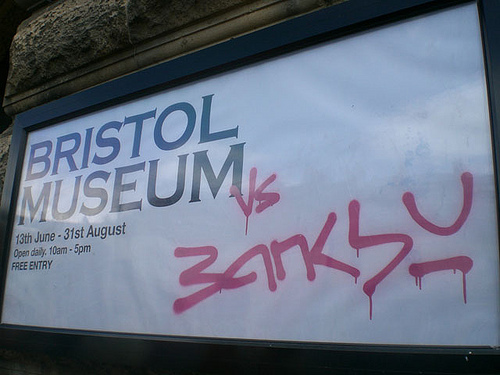 And it also added to the irony of the occasion, as you’re shepherded into a really old-fashioned museum by security guards employed by an artist who has built his reputation on dodging security guards. And this is to see art that has an image that is supposed to be way too rebellious to be sanctioned by fusty old institutions such as this.
And it also added to the irony of the occasion, as you’re shepherded into a really old-fashioned museum by security guards employed by an artist who has built his reputation on dodging security guards. And this is to see art that has an image that is supposed to be way too rebellious to be sanctioned by fusty old institutions such as this. 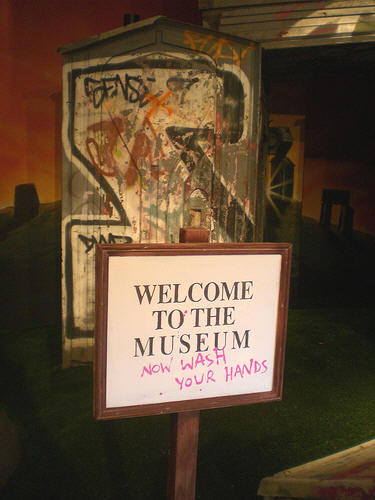
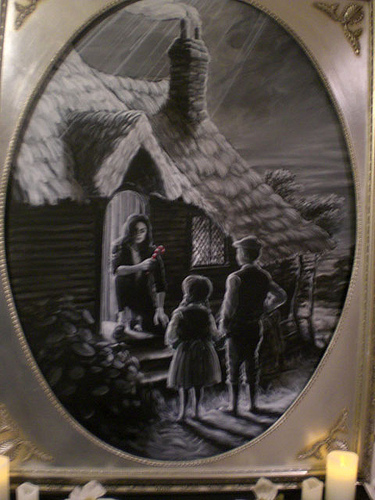 The walls of the rest of this gallery are covered in “original” Banksys (as far as “original” work is concerned, just about every image in the show is a remix or update of existing cultural product), paintings on canvas, modified reproductions of paintings, small drawings.
The walls of the rest of this gallery are covered in “original” Banksys (as far as “original” work is concerned, just about every image in the show is a remix or update of existing cultural product), paintings on canvas, modified reproductions of paintings, small drawings. 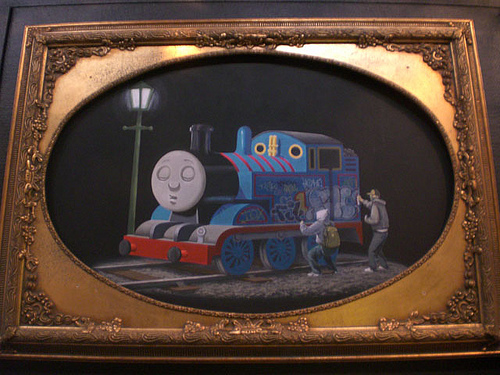 In the next room are the pieces that I’ve really come to see, the animatronic petshop. There are surveillance cameras acting like roosting birds, fish fingers swimming round a goldfish bowl and lots of little cages with pet sausages wiggling about in them.
In the next room are the pieces that I’ve really come to see, the animatronic petshop. There are surveillance cameras acting like roosting birds, fish fingers swimming round a goldfish bowl and lots of little cages with pet sausages wiggling about in them. 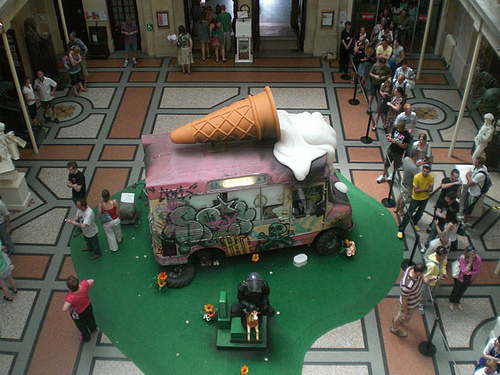
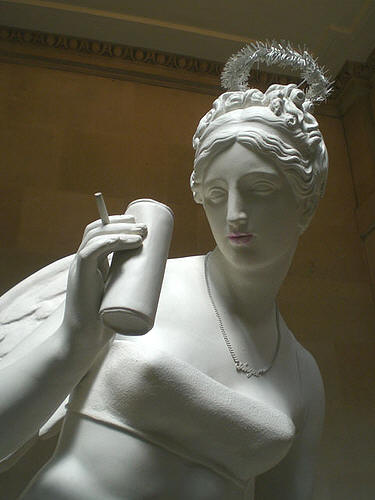 cool and white-walled and trendily-converted former industrial-space like the Tate, Arnolfini, Exchange, etc etc.
cool and white-walled and trendily-converted former industrial-space like the Tate, Arnolfini, Exchange, etc etc. 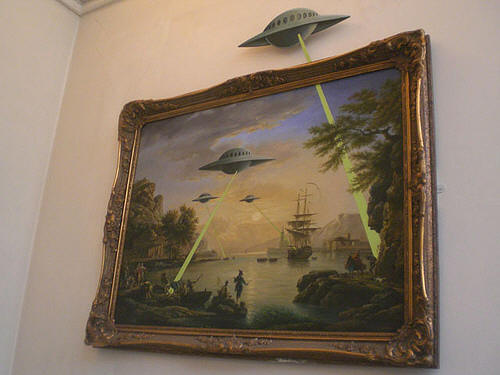 If being subversive means it undermines the way we currently relate to art, globalised capitalism, and the mythology of artist-genius, then of course Banksy’s work isn’t subversive at all. The way the world is at the moment, to work as an autonomous artist and to live out the myth of individualism by “expressing yourself” requires an amount of financial cushioning, whatever scale you work on. Banksy is best-known for his unsanctioned painterly interventions into the civic landscape. Remaining anonymous may be sensible to remain ahead of the legal repercussions associated with this kind of activity, but this is a pseudo-anonymity, as the signature BANKSY has often featured heavily. The artist with the Banksy tag has been using the celebrity-commodity system in a very pure form, creating the specific artist name, artworks related to this name and the idea of one person as a genius behind it. Speculation about the “real person” behind the name creates a media story which Banksy continues to exploit. So the artwork follows the specific rules of capitalist production, aimed to accumulate economic capital and/or symbolic capital which is the currency of all scenes and subcultures.
If being subversive means it undermines the way we currently relate to art, globalised capitalism, and the mythology of artist-genius, then of course Banksy’s work isn’t subversive at all. The way the world is at the moment, to work as an autonomous artist and to live out the myth of individualism by “expressing yourself” requires an amount of financial cushioning, whatever scale you work on. Banksy is best-known for his unsanctioned painterly interventions into the civic landscape. Remaining anonymous may be sensible to remain ahead of the legal repercussions associated with this kind of activity, but this is a pseudo-anonymity, as the signature BANKSY has often featured heavily. The artist with the Banksy tag has been using the celebrity-commodity system in a very pure form, creating the specific artist name, artworks related to this name and the idea of one person as a genius behind it. Speculation about the “real person” behind the name creates a media story which Banksy continues to exploit. So the artwork follows the specific rules of capitalist production, aimed to accumulate economic capital and/or symbolic capital which is the currency of all scenes and subcultures.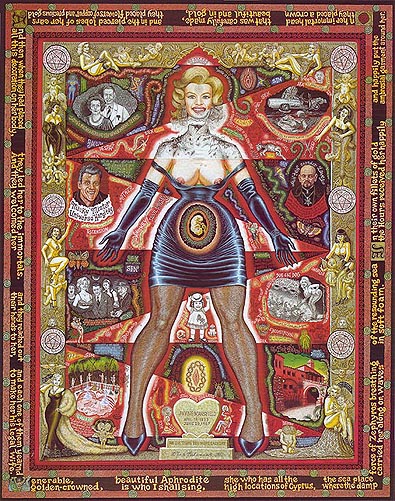 There are flaws in the concept of an 'art world', it is a fact of postmodern life that there exist many parallel, overlapping and contra-orbital art worlds.
There are flaws in the concept of an 'art world', it is a fact of postmodern life that there exist many parallel, overlapping and contra-orbital art worlds.  In some cases it can be argued that the creator acted without any artistic intention, creating as part of a private personal belief system, rather than social reasons. For example, during his lifetime Henry Darger worked as a lavatory cleaner in Chicago hospital. He was never known as someone who wanted to be an artist. His work was created in secret, most likely for personal fetishistic reasons, and was only found by his landlord some months after his death. In divorcing his illustrations from their private functional context and placing them within a public gallery arena, the function of these objects is changed. Something which may have had personal religious or devotional meaning becomes secularised, as an item for bourgeois cultural consumption.
In some cases it can be argued that the creator acted without any artistic intention, creating as part of a private personal belief system, rather than social reasons. For example, during his lifetime Henry Darger worked as a lavatory cleaner in Chicago hospital. He was never known as someone who wanted to be an artist. His work was created in secret, most likely for personal fetishistic reasons, and was only found by his landlord some months after his death. In divorcing his illustrations from their private functional context and placing them within a public gallery arena, the function of these objects is changed. Something which may have had personal religious or devotional meaning becomes secularised, as an item for bourgeois cultural consumption.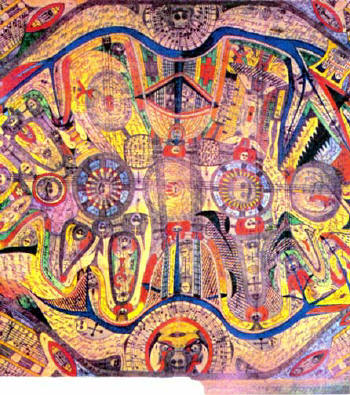





















 But I like a bit of cheese. Talking of which, there's one piece here that really stands out here. There is a glass fronted chiller cabinet with cheese boards with the words cow, goat, sheep, buffalo and human carved into them . On top of each is a chunk of some sort of fatty substance, which I find out (to my relief) is cheese.
But I like a bit of cheese. Talking of which, there's one piece here that really stands out here. There is a glass fronted chiller cabinet with cheese boards with the words cow, goat, sheep, buffalo and human carved into them . On top of each is a chunk of some sort of fatty substance, which I find out (to my relief) is cheese.